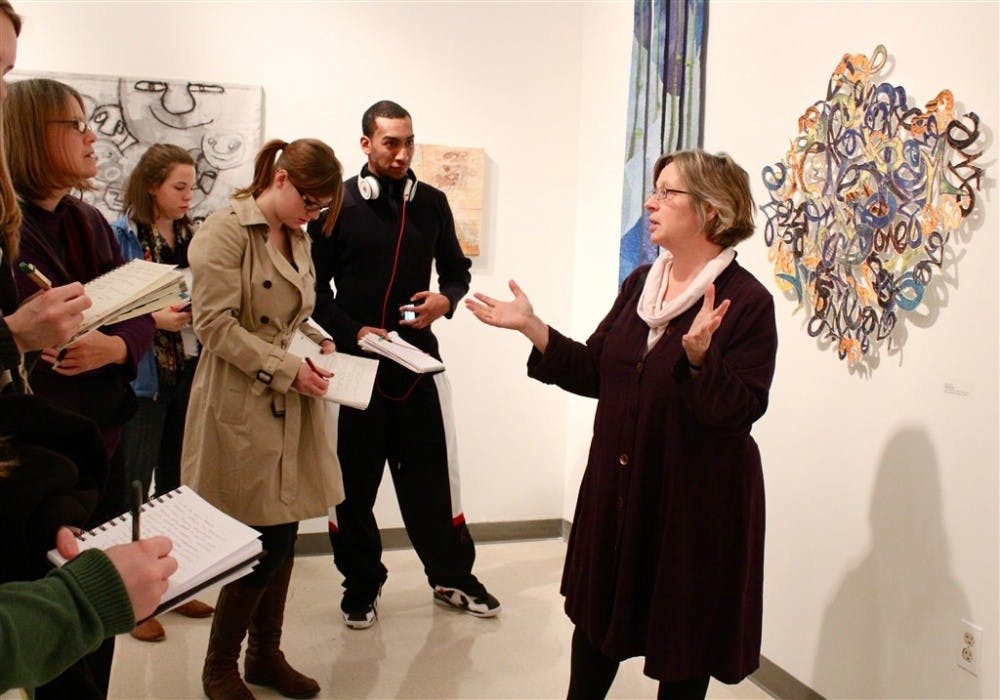Fibers have woven their threads through history to become more than just clothes worn on a person's body. They unite people and give artists a unique creative outlet, as shown at Elon University's Fabulous Fibers exhibit Jan. 9 in Arts West Gallery.
"Fiber is so intrinsic in our comfort level and it's something we're all familiar with," said LM Wood, curator of the exhibit and associate professor of art. "It is an attraction like no other."
"Attraction" is a word the 28 artists represented in the exhibit might use to describe their relationship to fiber work. Many of the pieces represented took up to 50 hours to complete, according to Wood.
The ways to make fiber art are wide-ranging and frequently transcend traditional thread and yarn. The displays at the exhibit utilized materials ranging from inkjet printing to wool to rug and plastic bags, such as artist Miyuki Sakai's "Plastic Series 2: Field."
"A lot of the pieces are generated from very personal stories," Wood said. "My experience is that you develop a body of work and see where it leads you. These folks are the masters of fiber-based work."
All of the artists in the exhibit were from North Carolina, many of whom had been represented at previous fiber exhibits at Elon. This year's display marked the fourth time Elon has hosted a fiber art exhibit, the first one being in 2001, Wood said. The artists all had different perspectives and ideas about how to construct art and meaning through thread.
"When they were building railroads at the turn of the century in Canada, they had also been building vistas," said Nancy Pickens, an artist whose work was exhibited. "They had these really vibrant landscapes."
Pickens' experience with the colorful Canadian views inspired her to create a wool-based piece entitled "Landscape," which depicted a forest scene with splashes of color blended throughout.
Pickens has had no previous experience in the arts.
"I didn't take any art classes," she said. "I was a crocheter, knitter, costume designer. I was the crafty person."
Many of the artists come from diverse backgrounds and used different elements of their personal lives and experiences to create a work of art.
"My piece is all hand- stitched with layers of hand- dyed silk and organza beads," said Peg Gignoux, who created an exhibited piece called "POPPIES." "My inspiration comes from my walks in France. I brought the day and night together and was inspired by Renoir's red poppies."
Some artists focused more on one medium while other artists explored blending together many different types of media, all to produce greatly varied results.
"Some explore, others are experts in one medium," Wood said. "Many of the artists are teachers and many are savvy with multiple media."
One artist, David Schaeffer, simply attached one red string from a point on the wall to the floor, calling the piece "Activated Space MMXII."
"Think about one tiny string cultivating an entire space," Wood said.
Some of the pieces were radical whereas others were more traditional woven tapestries.
"Students get to see a wide variety and a range of process, execution and maturity," Wood said. "You're not going to see a lot of repetition."
Gignoux said region plays a large part in the fiber art community.
"In the South, from my experience, the arts are open and it's an easy place to dye and rinse cloths outside," she said. "It's easier to be an artist down South. Technology has made artists into fiber artists. The time that we live in is exciting for textiles."
A large part of Wood's artistic interest involves how the digital world can interact with the art world.
"The very first computer was an old loom that used punch cards," she said. "A lot of artists use this concept in digital weaving. There are fiber artists looking at LED. Artists are thinking about natural fibers, natural ways of making colors."
No matter the technique or background of each artist represented in the exhibit, there was an abundance of unique perspectives on what art is and how fiber art can illustrate concepts and stories.
"Communities are built around making fibers," Wood said. "These people are very much in the process of making things, the tangible experience"


